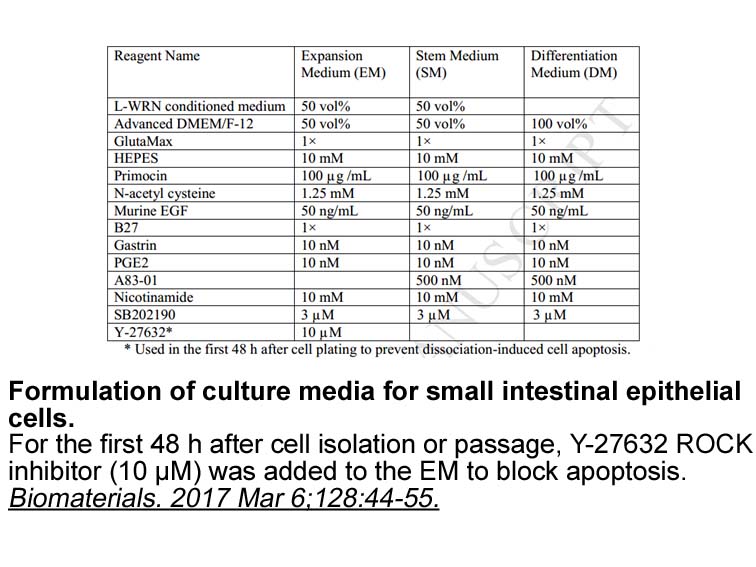Archives
br Conclusion In conclusion we showed that apoptosis is invo
Conclusion
In conclusion, we showed that apoptosis is involved in etoposide-induced pancreatic β-cell cytotoxicity. More importantly, as shown in Fig. 6, the results of this study demonstrated that etoposide induces pancreatic β-cell death via the JNK/ERK activation-mediated GSK-3 downstream-triggered mitochondria-dependent apoptosis pathway. These findings may be explaining the cytotoxic activity of this drug and unwanted side-effects in normal viable 99026 observed in clinical.
Conflict of interest
Acknowledgments
This work was supported by research grants from Taichung Tzuchi Hospital, The Buddhist Tzuchi Medical Foundation (TTCRD 101-13), the Ministry of Science and Technology, Taiwan (MOST 103-2314-B-039-014) and in part by Taiwan Ministry of Health and Welfare Clinical Trial and Research Center of Excellence (MOHW105-TDU-B-212-133019).
Introduction
Aberrant protein kinase signaling has been implicated in many human diseases. Protein kinases have thus become important targets for design and development of therapeutic agents. Identification and development of compounds that manipulate cellular activity of various kinases is a major focus of pharmaceutical research. Glycogen synthase kinase-3 (GSK-3) is a serine/threonine kinase expressed as two similar isoforms, α and β, that are abundant in most tissues [1]. GSK-3 was initially implicated in insulin signaling and metabolic regulation, but later studies identified additional roles in embryogenesis, mitotic regulation, inflammation, and neuroplasticity [2], [3], [4], [5]. Unlike many other protein kinases, which are typically activated by extracellular signaling, GSK-3 is constitutively active in resting conditions  and undergoes rapid inhibition by variety of stimuli. This is achieved by phosphorylation of a serine residue located at the N-terminus of the enzyme that is catalyzed by various upstream protein kinases mainly from the AGC family [2], [6], [7]. GSK-3 plays a central part in many cellular functions, contributing to the regulation of apoptosis, cell cycle, cell polarity, and gene expression [2], [4], [8], [9], [10]. Phosphorylation of GSK-3 downstream targets typically results in attenuation of the signaling pathway and/or inhibition of the substrate's activity. For example, GSK-3 phosphorylates and inhibits glycogen synthase [11], [12] and it inhibits insulin signaling via the phosphorylation of the insulin receptor substrate proteins IRS-1 and IRS-2 [13], [14]. GSK-3 is also a key suppressor of the canonical Wnt signaling pathway that controls cell fate determination and cell renewal [15], [16], [17]. Phosphorylation of β-catenin, a key target in Wnt pathways, by GSK-3, enhances its proteosomal degradation and suppresses its transcriptional activity [18], [19]. Phosphorylation of additional transcription factors such as cAMP response element binding protein (CREB), nuclear factor of activated T cells (NFATc), heat shock factor-1 (HSF-1), and nuclear factor κB (NFκB) by GSK-3 inhibits their transcriptional activity [20], [21], [22], [23]. It is not surprising that abnormally elevated activity of GSK-3 is found in several pathological disorde
and undergoes rapid inhibition by variety of stimuli. This is achieved by phosphorylation of a serine residue located at the N-terminus of the enzyme that is catalyzed by various upstream protein kinases mainly from the AGC family [2], [6], [7]. GSK-3 plays a central part in many cellular functions, contributing to the regulation of apoptosis, cell cycle, cell polarity, and gene expression [2], [4], [8], [9], [10]. Phosphorylation of GSK-3 downstream targets typically results in attenuation of the signaling pathway and/or inhibition of the substrate's activity. For example, GSK-3 phosphorylates and inhibits glycogen synthase [11], [12] and it inhibits insulin signaling via the phosphorylation of the insulin receptor substrate proteins IRS-1 and IRS-2 [13], [14]. GSK-3 is also a key suppressor of the canonical Wnt signaling pathway that controls cell fate determination and cell renewal [15], [16], [17]. Phosphorylation of β-catenin, a key target in Wnt pathways, by GSK-3, enhances its proteosomal degradation and suppresses its transcriptional activity [18], [19]. Phosphorylation of additional transcription factors such as cAMP response element binding protein (CREB), nuclear factor of activated T cells (NFATc), heat shock factor-1 (HSF-1), and nuclear factor κB (NFκB) by GSK-3 inhibits their transcriptional activity [20], [21], [22], [23]. It is not surprising that abnormally elevated activity of GSK-3 is found in several pathological disorde rs. The mechanisms by which GSK-3 contributes to human disease are summarized in Fig. 1.
The involvement of GSK-3 in ‘unrelated’ fields appears extraordinary. However, accumulated data now indicate that metabolic dysregulation contributes to the pathophysiology of neurological and psychiatric diseases. For example, unbalanced nutrient intake or dysregulation in insulin signaling appears to influence the risk of clinical dementia and Alzheimer's disease [24], [25]. It is also noteworthy that the contribution of GSK-3 to inflammatory processes may underlie mechanisms coupling GSK-3 with diabetes, obesity, neurodegenerative disorders, and cancer [4]. GSK-3 thus became a prime target in drug discovery and development of GSK-3 inhibitors is of major interest in pharmaceutical research.
rs. The mechanisms by which GSK-3 contributes to human disease are summarized in Fig. 1.
The involvement of GSK-3 in ‘unrelated’ fields appears extraordinary. However, accumulated data now indicate that metabolic dysregulation contributes to the pathophysiology of neurological and psychiatric diseases. For example, unbalanced nutrient intake or dysregulation in insulin signaling appears to influence the risk of clinical dementia and Alzheimer's disease [24], [25]. It is also noteworthy that the contribution of GSK-3 to inflammatory processes may underlie mechanisms coupling GSK-3 with diabetes, obesity, neurodegenerative disorders, and cancer [4]. GSK-3 thus became a prime target in drug discovery and development of GSK-3 inhibitors is of major interest in pharmaceutical research.